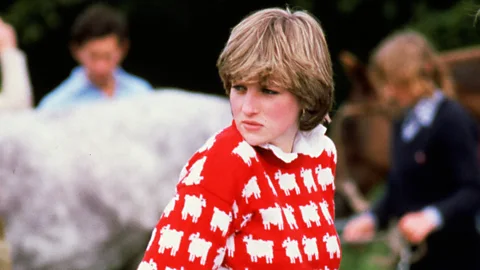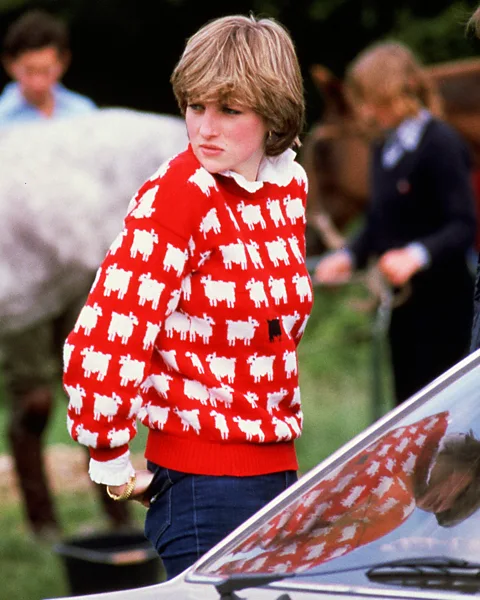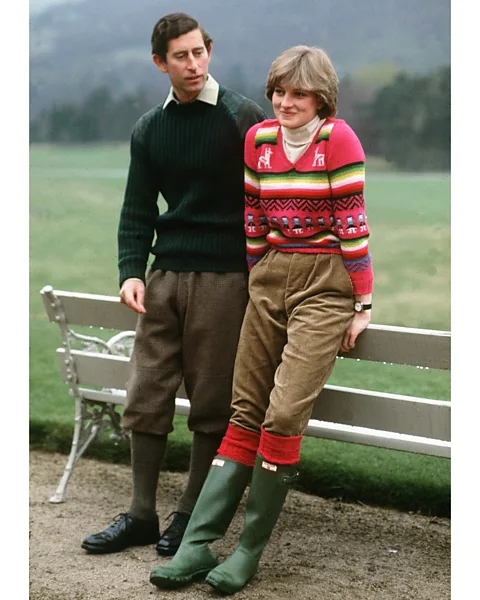What Princess Diana's sheep jumper really means

The sweater – just auctioned at Sotheby's for an astonishing $1.4 million – is a symbol of her journey from whimsical, Sloaney ingenue to powerful communicator, and eventual outsider, writes Lindsay Baker.
An iconic piece of British royal history has just been auctioned – neither diamond tiara nor couture evening gown, it's a red novelty jumper featuring a whimsical sheep pattern by small brand Warm and Wonderful. The 19-year-old then Lady Diana Spencer wore the sweater in June 1981 to a polo match where she watched her fiancé Prince Charles compete. It was four months after the announcement of their engagement, and much has been made since then of this fashion moment, with commentators saying that the knitted pattern, featuring a single black sheep among many white ones, was "a cheeky nod from Diana about how she viewed herself within the Royal Family - the odd one out".
More like this:
But was this sartorial choice really an intentional manifestation of the teenage Diana's innermost fears and emotions? Was it a subtle signal – Lady Diana semaphoring to the world a sense of herself as a "black sheep" and an outsider? No, according to author, curator and fashion historian Eleri Lynn, who is also a Trustee at the Royal School of Needlework. "We're probably reading more into it in hindsight," Lynn tells BBC Culture. "I don't believe at that time she would have had a sense of the 'one black sheep' idea, or that she even had a sense of the impact of the fashion she wore. She was a very young woman who was developing her own sense of style. She was very much of her time in terms of fashion. She was dressing like her peers, and was very playful in what she wore. She was not yet at that stage of communicating through fashion."
Sally Tuckett, fashion historian at Glasgow University agrees: "The 80s were all about vibrant (often clashing) colours and bold statements, something that was particularly apparent in knitwear designs of the era. The 'black sheep' jumper fits perfectly into this, particularly with the contrasting colours and repeat of the sheep pattern, and it also speaks to the rise of British knitwear and design at this time."
Worn with the glimpse of a Peter Pan collar peeping out at the neckline, the sheep jumper is interesting in another way, though, according to Lynn – as a class signifier. It is typical of a classic early 80s Sloane look (the Sloane Ranger, a particular type of upper-class or upper-middle-class British person, was so named after Sloane Square, Chelsea, a favourite Sloaney spot in London). "She was a Sloane Ranger, the jumper was a playful part of her wardrobe." Arguably, as a bona fide Sloane in 1981, aged 19, and about to marry the heir to the throne, Diana was anything but an outsider – she was at the epicentre of the most exclusive club in Britain. The early 80s was the Sloane's heyday – The Sloane Ranger Handbook was published in 1982, and in it Diana was awarded the title "Supersloane".
 Getty Images
Getty ImagesIn Luella Bartley's book Luella's Guide to English Style the author and designer sings the praises of the 80s Sloane Ranger, as "personified" by Diana, in a chapter titled Tribes of Britannia: "My Sloane is the 80s Sloane," Bartley writes. "The rigidity of her uniform and the rules by which she lives deserve to be preserved. Sloanes wear red, white and blue to fly the flag, announce their loyalties, and stick to what they know. Blue is regimental, nautical, and goes with everything. Red is jolly. White is the colour of school shirts and the snow at Verbier."
And the other thing about Sloanes, according to Bartley's book? "They are good at fun… practical jokes, fancy-dress balls and silly nicknames. What they hate is anyone trying to be clever. They are avowedly anti-intellectual and can't abide anyone taking him/herself too seriously." In her red-and-white, "jolly" and cartoonish sheep jumper, with white Peter-Pan blouse and navy jeans – could early 80s Diana at the polo have been any more quintessentially Sloaney?
A sense of mischief
Yet although in 1981 Diana was neither an outsider nor much of a rebel, over the following years, according to Eleri Lynn, she did begin to enjoy surprising people with her fashion choices. The sheep jumper was an early indication of this "mischievousness", as Lynn calls it. "I can't comment on what she was thinking. But couturiers have described how she did like to be subversive. She did enjoy the idea of surprising people, and dressing with little twists, or something unconventional – for example wearing mismatching evening gloves, one red and one black, wearing a tuxedo trouser suit, patterned tights. Or wearing black, which royal protocol says is only for mourning and funerals. She loved it. And she was totally responsible for her clothes and if she didn't like it, she wouldn't wear it. It was always her choice."
Lynn points to another iconic piece of knitwear – the bright-pink llama-themed jumper she wore at Balmoral just before the wedding. "She loved 'country-house dressing' but with a twist – so she wore the fun pink jumper with classic jodhpurs or trousers tucked into her Hunter wellies, or the fantastic tweed bomber jacker she wore, converting a country wardrobe classic with a contemporary youthful twist."
The way in which Diana became more and more adept at her messaging through fashion has been well documented. In the exhibition Diana: Her Fashion Story, her journey from ingenue to powerful communicator was explored. Lynn, who curated the exhibition, says that, with the help of couturiers, "a new world opened up for her, where fashion could be a pivotal communicator. And she had a lot of fun with it. She began to realise, after the wedding [in 1981], the impact she was having, and she retained the playfulness and subversiveness, knowingly pushing the boundaries".
 Getty Images
Getty ImagesThis playfulness and modernity steadily became an integral part of Diana's identity, argues Lynn. "You can see it in her choices, and it speaks to something wider, about breaking royal protocol in other ways – when she met with Aids patients, hugged children, and broke with convention. And her fashion reflects that personality.
"The sheep sweater speaks to that playfulness, speaks to a mischievousness, a subversiveness. But it was done without fully appreciating the power that her image was going to have." That Diana did, in the end, become an outsider in the eyes of "The Firm" – and subsequently so loved across the world – is ultimately what makes this piece of royal memorabilia so iconic. And it's iconic also because it holds within its story, and its wearer's story, so many elements – dramatic irony, an essence of tragedy, a spirit of comedy, a poignancy – and an undeniable charisma.
If you liked this story, sign up for the weekly bbc.com features newsletter, called The Essential List. A handpicked selection of stories from BBC Future, Culture, Worklife and Travel, delivered to your inbox every Friday.
